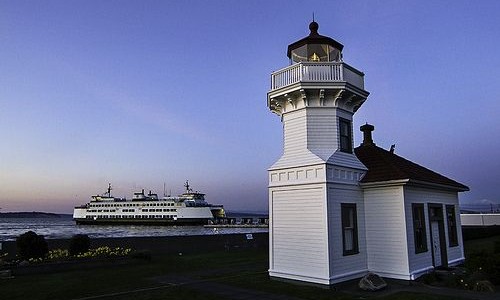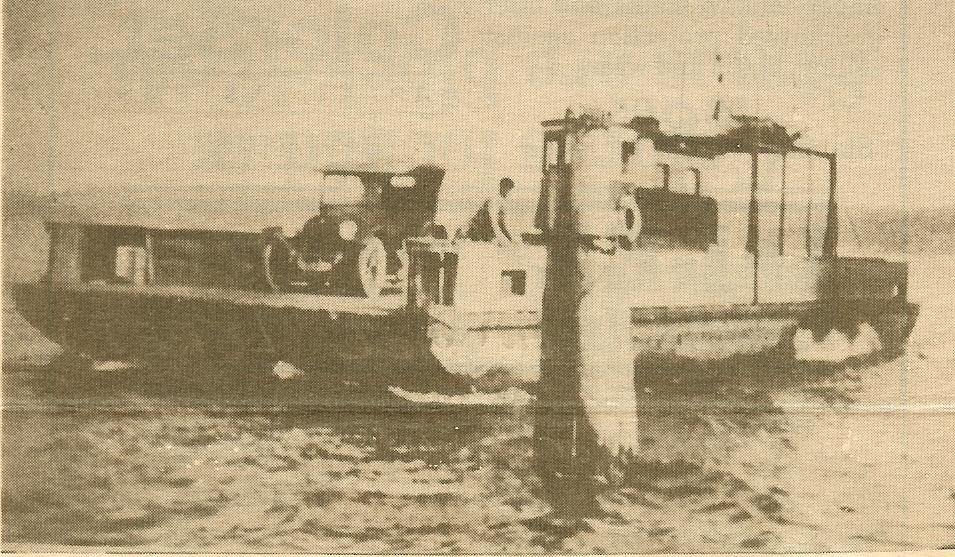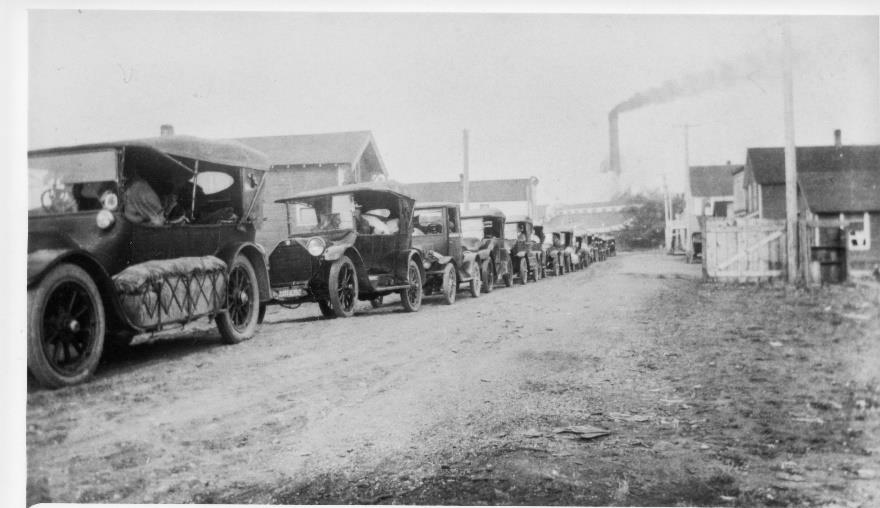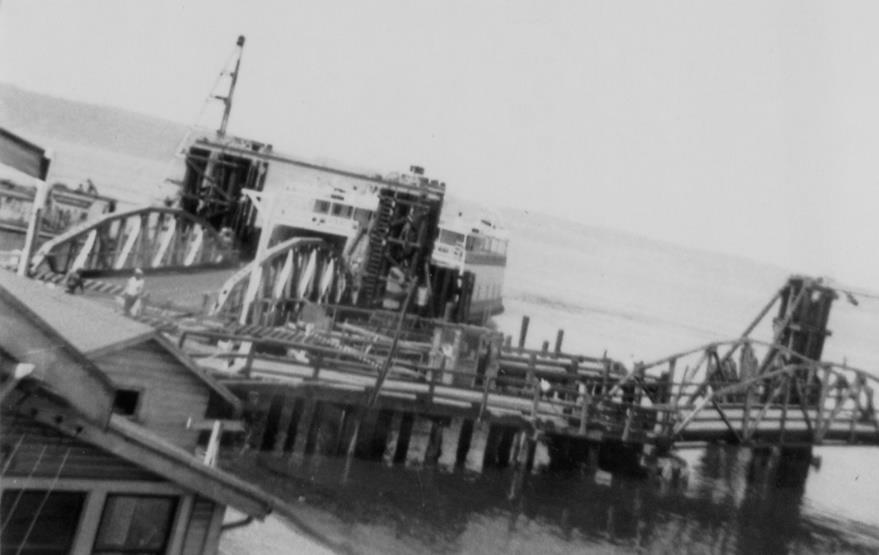By Peter Anderson, Director, Mukilteo Historical Society
Newcomers to Mukilteo may be unaware of the storied history of the property at 710 Front Street, now known as Ivar’s Mukilteo Landing. Although we have not found ownership records prior to 1923, it’s possible the property changed hands multiple times during earlier periods of Mukilteo’s boom and bust. After Mukilteo’s founding in 1860, speculators bought large tracts of land and divided them into many smaller lots expecting to sell them at big profits. The Depressions of 1873 and 1893 forced many property owners into receivership.

In 1923, Howard Josh bought the property where Ivar’s now stands from Ottilie Herzog and John and Mary Gunnarson. Ottilie Herzog had previously inherited a 50% interest in the property from Jacob Klein. A 1909-1910 Oregon and Washington Gazetteer and Business Directory lists Elmer D. Ward and Jacob F. Klein as proprietors of a saloon in Mukilteo. John and Mary Gunnarson owned the other 50% share. In 1924, Howard Josh put up a small lunchroom on this property next to the ferry landing for the enjoyment of commuters and vactioners to Whidbey Island.
In about 1925, the Josh family built a large house next to the small lunchroom. In 1926, the small lunchroom was moved to the other side of the ferry dock in order to make room for a larger building. The smaller building was converted into accommodations for fishermen, while the larger building served as a restaurant and store for fishing supplies. It had cases of fishing tackle and candy and a small ice cream fountain. As demand for temporary accommodations increased, several rooms upstairs were rented to vacationers.
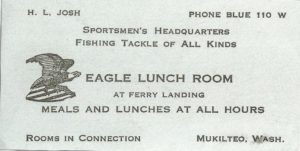
Howard Josh was a member of the Fraternal Order of Eagles and decided to name his restaurant the Eagle Lunch Room. It served ferry passengers, fishermen and townsfolk alike. It also provided meals for longshoremen when extra gangs were called in to help load ships. In 1929, the Blackball Ferry Line installed a ticket office and waiting room inside the Eagle Lunch Room.
Depression again in the 1930s brought new owners to the property. Mr. and Mrs. Jack Burke bought the property and renamed it the Ferry Lunch Room. Sometime during their tenure, a “mysterious” explosion caused considerable damage to the interior. In 1934, the Baker family took over from the Burkes. The Baker brothers had been operators of the Regis Café in Stanwood for many years. A news article appearing in the August 2, 1934, Twin City News reported that Van Baker had just sold his interest in the Regis Café to Frank Obenhofer of Stanwood. It seems likely that Van Baker (aka Wilson Vanhorn Baker) used the proceeds of the sale to buy the Mukilteo property. His 1942 WW II Draft Registration card lists him residing in Mukilteo and self-employed at Ferry Lunch.

In 1944, Ed Taylor Sr. and his wife, Mildred, bought the property from the Baker family. Born in Wisconsin in about 1892, Edgar Taylor Sr. came to Everett in 1903. After he had completed his education, he worked in a shingle mill for a time and later for the Lake Stevens Trading Company. In 1914, he established the Independent Truck Company, and operated a very successful business in Everett for many years. In 1917, he married Mildred Leo, a school teacher, and they had two sons, James Richard (“Dick”) and Edgar Jr.
The Taylor’s friends were quite skeptical when the Taylor family decided to buy the Ferry Lunch in 1944. The Taylors had no experience managing a restaurant. At the time, the Ferry Lunch was still a relatively small lunch room catering to ferry travelers and fishermen. Mrs. Mildred Taylor would cook clam chowder and other specialties in her own kitchen, and then take them to be served in the restaurant next door. As the business grew, the Taylor sons, Dick and Ed Jr., joined in the operations, making several additions and improvements. In 1962, a dining area was added out over the water so diners could watch the ferry and other waterfront activity.
Ed Taylor Sr. died in 1951, at the age of 58, and his wife, Mildred, died in 1969, at the age of 78. Their sons Dick and Ed Jr. continued to operate the restaurant and make improvements. After the death of their parents, Dick and Ed Jr. tore down the family house next to the restaurant, added a new large cocktail lounge in this area and changed the name to Taylor’s Landing. They retained part of the space for a gift shop, fishing supplies and a sidewalk lunch counter for ice cream and short order items.
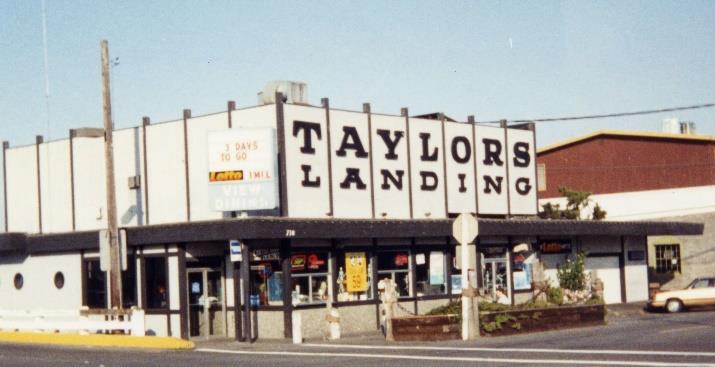
Taylor’s Landing became a very popular spot, and Dick and Ed Jr. were active in community affairs. Ed was instrumental in starting the annual Mukilteo Lighthouse Festival as well as the Mukilteo Boys and Girls Clubs annual luau fundraiser. Dick was on Mukilteo’s first City Council , was the City’s second mayor, and went on to serve in the state legislature. In 1979, Dick and Ed were jointly named Mukilteo Citizens of the Year.
In the 1980s, Dick Taylor retired to the family beach home on Whidbey Island with his wife, Irene. Taylor’s Landing continued as a family business operated by Ed and subsequent generations until the property was sold to Ivar’s in 1991. Ed’s son, Tim Taylor, was running the restaurant at the time it was sold to Ivar’s. A reunion of former Taylor’s Landing workers was held in 2015.
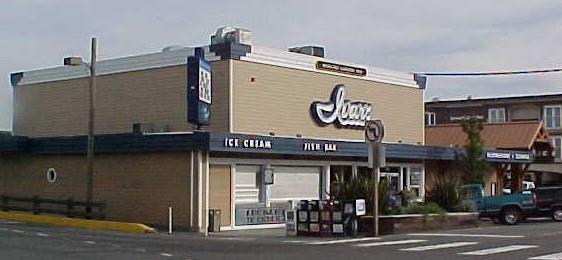
The most recent chapter in the property’s story was written on February 25, 2016, when Ivar’s Real Estate Associates LP sold the property to MSI Mukilteo LLC. The sale did not affect restaurant operations. MSI (Martin Smith Inc.) owns and manages a portfolio of historic office and retail buildings in the greater Seattle area. Interestingly, the company is led by H. Martin Smith III, whose father, H. Martin Smith Jr., was a cousin of Ivar Haglund, the founder of Ivar’s restaurants. Although we don’t know what lies in the future for the Mukilteo property, it’s probably best to heed the advice from Ivar’s motto: Keep Clam!
Originally published in the 8/1/2018 issue of the Mukilteo Beacon.
